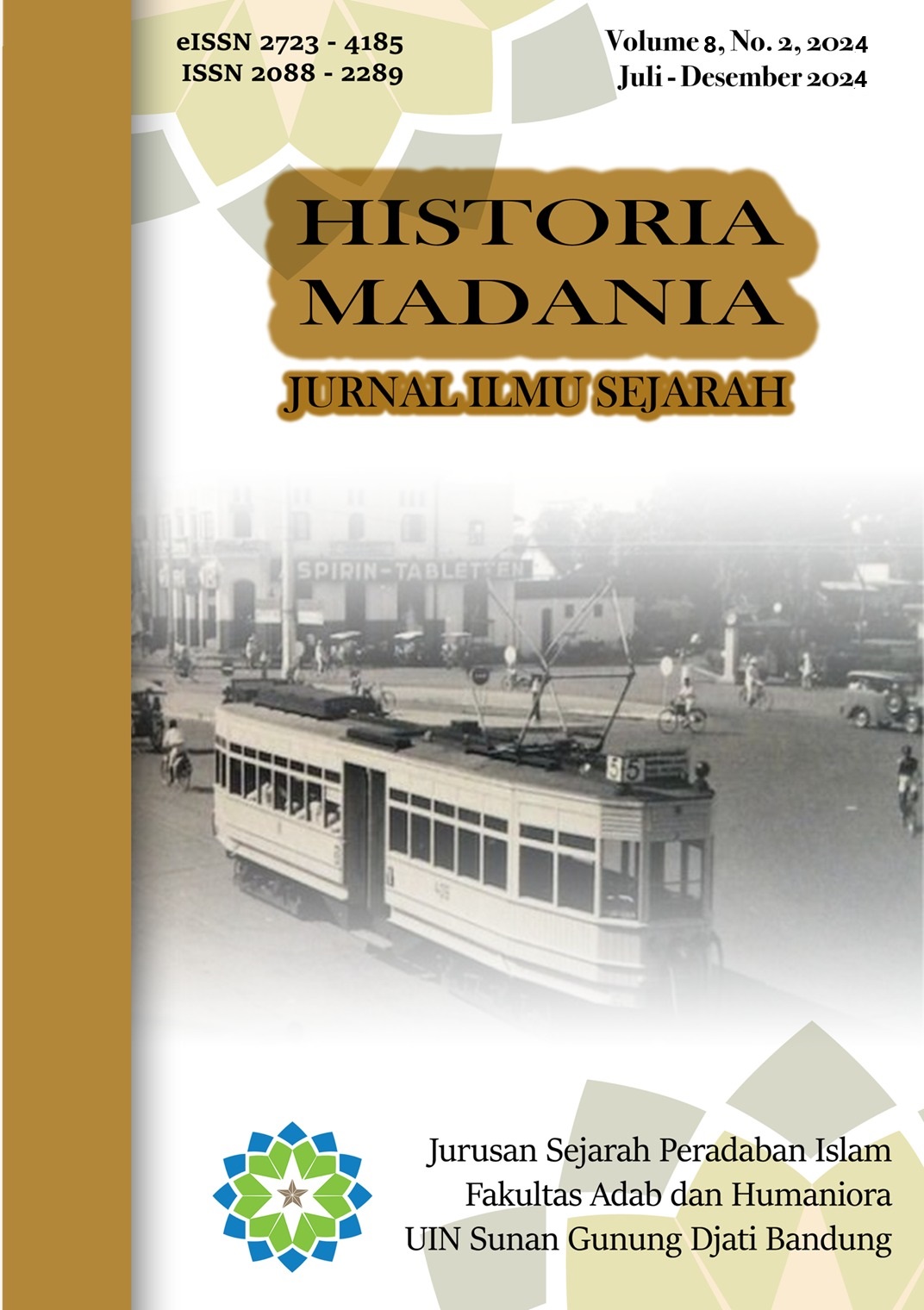Handel In Lampongsche Districten: International Trade in Lampung District 1867 – 1914
DOI:
https://doi.org/10.15575/hm.v8i2.38768Abstract
References
Ahmad Benny Syahputra, Miftahuddin & Putri Nurhayati. (2024). Pesantren Kyai Hasanudin in the Development of Islamic Education in Lampung in the Early 20th Century. HISTORIA: Jurnal Program Studi Pendidikan Sejarah. 12 (1). 12. http://dx.doi.org/10.24127/hj.v12i1.8203
Aliza Oktaviani, Sufi Sopan Mahdi & Valensy Rachmedita. (2024). Perkembangan Transportasi Kereta Api sebagai Penunjang Industri Perkebunan di Keresidenan Lampung 1830-1933. Historia Madania: Jurnal Ilmu Sejarah. 8 (1). 101. https://doi.org/10.15575/hm.v8i1.21223
Blink. (1928). Opkomst En Ontwikkeling Van Sumatra Als Economischgeographisch Gebied. 'S-Gravenhage — Mouton & Co.
Bobi Hidayat & Johan Setiawan. (2023). The Talangsari Incident in Lampung in 1989: A Review of Social History. HISTORIA: Jurnal Program Studi Pendidikan Sejarah. 11 (2). 232. http://dx.doi.org/10.24127/hj.v11i2.7477
Broersma, Dr. (1916). De Lampongsche Districten. Batavia : Javasche Boekhandel & Drukkerij.
Departemen Pendidikan dan Kebudayaan Provinsi Lampung. (1997). Sejarah Daerah Lampung. Jakarta : Departemen Pendidikan dan Kebudayaan.
Gottschalk, Louis. (1975). Mengerti Sejarah. Terjemahan Nugroho Notosusanto. Jakarta: Yayasan Penerbit Universitas Indonesia
Gregorius Andika Ariwibowo. (2021). KOTA DAN JARINGAN KOSMOPOLITAN: BANTEN PADA MASA KEJAYAAN JALUR REMPAH NUSANTARA ABAD XVI HINGGA ABAD XVII. Patanjala : Jurnal Penelitian Sejarah dan Budaya. 13 (2). 144. http://dx.doi.org/10.30959/patanjala.v13i2.800
Iim Imadudin. (2016). PERDAGANGAN LADA DI LAMPUNG DALAM TIGA MASA (1653-1930). Patanjala : Jurnal Penelitian Sejarah dan Budaya. 8 (3). 350 http://dx.doi.org/10.30959/patanjala.v8i3.14
Lia Nuralia & Iim Imadudin. (2021). NILAI BUDAYA PADA LANSKAP INDUSTRI PERKEBUNAN KINA CINYIRUAN BANDUNG PADA MASA KOLONIAL. Patanjala : Jurnal Penelitian Sejarah dan Budaya. 13 (2). 177. http://dx.doi.org/10.30959/patanjala.v13i2.848
Setio Widodo & Endang Supriatin. (2023). Menelurusi Arus Migrasi di Lampung dalam Tiga Masa. HISTORIA: Jurnal Program Studi Pendidikan Sejarah. 11 (2). 213. http://dx.doi.org/10.24127/hj.v11i2.7466
Sjamsuddin, H. (2012). Metodologi Sejarah. Yogjakarta: Ombak.
Downloads
Published
How to Cite
Issue
Section
Citation Check
License
Authors who publish with this journal agree to the following terms:
- Authors retain copyright and grant the journal right of first publication with the work simultaneously licensed under a Creative Commons Attribution License that allows others to share the work with an acknowledgment of the work's authorship and initial publication in this journal.
- Authors are able to enter into separate, additional contractual arrangements for the non-exclusive distribution of the journal's published version of the work (e.g., post it to an institutional repository or publish it in a book), with an acknowledgment of its initial publication in this journal.
- Authors are permitted and encouraged to post their work online (e.g., in institutional repositories or on their website) prior to and during the submission process, as it can lead to productive exchanges, as well as earlier and greater citation of published work (See The Effect of Open Access).


